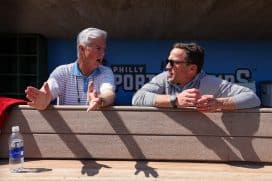Uncategorized
Analyzing the Flyers’ Trade Deadline Moves
(picture via zimbio.com)
The trade deadline came and went Wednesday at 3PM, and when the dust settled the Flyers made two moves that were very closely related to one another. First, on Tuesday afternoon they sent a 3rd round pick in the 2014 draft and a 2015 2nd rounder to the Islanders for defenseman Andrew MacDonald. MacDonald, who is 27, is making $550,000 this season and is a pending unrestricted free agent after the season. He had 4 goals and 20 assists in 63 games for the Islanders this season, and made his Flyers debut Wednesday evening against the Capitals, where he was a +2 in 18:07 TOI, picked up a secondary assist on Michael Raffl’s deflection goal, and was paired with Luke Schenn on the 3rd pairing. MacDonald’s role with the Flyers is expected to be dramatically reduced compared to his role with the Islanders, where he played 25+ minutes per game on their top pairing with Travis Hamonic, helping him become the league leader in blocked shots this year.
So what kind of addition is Macdonald? On the surface, he seems to be a very good one. His 25 points on the season ranks 2nd among Flyers defensemen behind only Mark Streit, and as previously mentioned he leads the league in blocked shots. However, the advanced statistics paint a much more grisly picture. His high assist totals are likely inflated by a 10.51% on-ice shooting percentage, and MacDonald’s Corsi For percentage is a disastrous 43.2%–worse than every Flyer but Zac Rinaldo, Jay Rosehill, and Adam Hall. His Corsi Rel is -20.4, meaning that for every 60 minutes he’s on the ice his team attempts 20 fewer shots than the opponents, an appallingly bad number. In fact, only 8 players in the NHL have a worse Corsi Rel than MacDonald. He was a major drag to his teammates as well, as illustrated by this chart of his minutes with his top-10 most frequent teammates:
|
Player |
TOI with MacD |
CF% with MacD |
TOI without MacD |
CF% without MacD |
CF% Difference |
|
Hamonic |
498:57:00 |
45.50% |
498:47:00 |
53.60% |
8.10% |
|
Okposo |
397:21:00 |
44.90% |
578:55:00 |
52.90% |
8.00% |
|
Tavares |
391:37:00 |
43.80% |
536:07:00 |
53.10% |
9.30% |
|
Bailey |
297:37:00 |
42.80% |
436:26:00 |
56.70% |
13.90% |
|
Vanek |
291:11:00 |
45.00% |
602:33:00 |
47.60% |
2.60% |
|
Strait |
282:47:00 |
42.10% |
318:19:00 |
47.40% |
5.30% |
|
Nielsen |
276:01:00 |
45.20% |
431:45:00 |
52.80% |
7.60% |
|
Hickey |
244:36:00 |
38.50% |
743:54:00 |
53.20% |
14.70% |
|
Grabner |
232:59:00 |
45.20% |
427:15:00 |
54.20% |
9.00% |
|
Cizikas |
223:35:00 |
36.20% |
406:15:00 |
47.10% |
10.90% |
Yikes. Every single one of his most frequent teammates does better without him, and with many of them the difference is staggering. Thomas Hickey improves by a whopping 14.7%, and Josh Bailey isn’t far behind at 13.9%. Other top players on the Islanders all have sizeable improvements away from MacDonald as well: John Tavares (9.3%), Kyle Okposo (8%), and Travis Hamonic (8.1%).
Now, to be fair, MacDonald was overextended on the Islanders after the loss of Lubomir Visnovsky during the season. He’s a limited talent, and asking him to play 25+ minutes a night on the top pairing against tough competition (His Corsi Rel QoC of 1.086 is 4th on the Flyers-only Matt Read, Braydon Coburn, and Sean Couturier have faced tougher opponents) is going to lead to disaster.
I think MacDonald is an upgrade over, say, Nick Grossmann, but the Flyers already had in-house options that were better than Grossmann, such as playing both Andrej Meszaros (49.1 CF%, 2.0 Corsi Rel) and Erik Gustafsson (48.7 CF%, -5.7 Corsi Rel) every game. To expend a 2nd and 3rd round pick to acquire such a limited talent reeks of making a trade for the sake of making a trade. Factoring in MacDonald’s pending UFA status, the Flyers’ desire to retain his services, and his rejection of a 4-year, $16M contract extension from the Islanders earlier this season, it seems like the Flyers would have been better off keeping Meszaros rather than trading him and letting him walk at the end of the season, thereby freeing up cap space for use in the summer. This swap (which amounts to Mez and a 2015 2nd for MacDonald) created more cap space for this season, but the Flyers didn’t make any more acquisitions before the deadline which rendered it moot.
When you factor in how low some of the prices on other players who could have helped the Flyers such as Thomas Vanek, Matt Moulson, and Ales Hemsky were, I think there’s not a doubt that the Flyers could have done better at the deadline. Vanek went to Montreal for a prospect and a conditional 2nd round pick in what was the steal of the trade deadline for the Canadiens, Moulson went to Minnesota for two 2nd round picks and a swap of depth centers, and Hemsky was sent to Ottawa for 3rd and 5th round picks. Vanek and Moulson both would have given the Flyers bona fide top-line LWs, which in turn would allow Scott Hartnell to reunite with Brayden Schenn and Wayne Simmonds on the 2nd line and utilize his unique play-driving skills with two players who need a little bit of help in that department. Hemsky is an undervalued scoring winger who could have been used anywhere in the top-9. Each of these players is a free agent at the end of the season, allowing the Flyers the choice to retain them or let them walk for cap flexibility as they saw fit depending on how the stretch run went.
With all that being said, however, MacDonald deserves a chance to prove himself in orange and black first. Perhaps facing easier competition and playing fewer minutes per night will lead to an improvement in the advanced statistics department for him. He’s definitely more mobile than the likes of Luke Schenn and Nick Grossmann while bringing their shot-blocking ability to the table, and he can play on both the penalty kill and the 2nd power play unit. However, it seems like MacDonald is merely another addition to the Flyers’ collection of low 2nd/3rd pairing players, and his ability to be an upgrade over Andrej Meszaros is questionable at best. The Flyers did well to recoup part of the cost of MacDonald by trading Meszaros, who they clearly deemed expendable. However, with everything previously mentioned in this article in mind, I’m of the opinion that the Flyers would have been better served holding onto the extra asset (a 2015 2nd round pick) that they gave up in swapping Meszaros for MacDonald, or utilizing it in another trade.












































